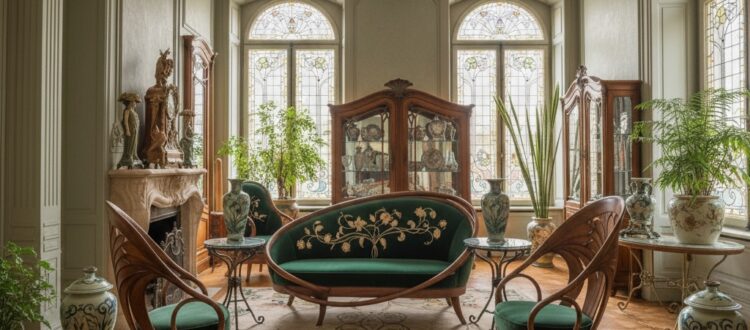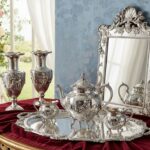The Magic of Art Nouveau Style Furniture
Have you ever admired furniture with long, sinuous curving lines with nature-inspired motifs? It was most probably an Art Nouveau furniture, with its graceful lines that you admired. Welcome to the world of Art Nouveau style furniture, where furniture isn’t just functional—it’s alive. With its flowing lines, floral motifs, and handcrafted detail, Art Nouveau furniture transforms everyday pieces into art. Furniture and decor that breathe and tell a story, if you are drawn to such design, then Art Nouveau furniture style is your muse—let’s explore why.

Art Nouveau Art Movement
What is the Art Nouveau movement? To understand this movement, think of the 19th century. Rapid industrialisation had led to mass production, which devalued craftsmanship and originality.
Artists across Europe rejected the mass production of Industrialisation and embraced an original style that took inspiration from their surroundings, not history.
The term “Art Nouveau” was popularised by the Paris art dealer Siegfried Bing, who named his gallery “Maison de l’Art Nouveau” in 1895 to describe the contemporary, new-style decorative arts he exhibited.
This movement rapidly gained momentum and artists embraced organic motifs, sinuous lines, and artisanal craftsmanship across art, architecture, décor, and furniture.
Art Nouveau Style
So, what is the Art Nouveau Style? Art Nouveau style captures the essence of nature—flowers, vines, insects—set into decorative, flowing lines known as the whiplash line. It rejected industrial repetition, favouring handmade craftsmanship and luxurious finishes.
https://www.youtube.com/watch?v=VBk5finx0Tw
Credit: Art History 101
Art Nouveau Furniture
Art Nouveau furniture embodies the balance between craftsmanship and elegance; it is the epitome of the magic of the turn of the century style. Curved lines, ornate details and precious woods – they are all the hallmarks of Art Nouveau furniture.
Origins of Art Nouveau Furniture
Art Nouveau Style Furniture originated in Europe around 1890-1910, a reaction against standardisation and mass production. It aimed for a new style that integrated art into everyday life. Most Art Nouveau furniture was based on the greatly influential designer Charles Rennie Mackintosh.
Characteristics of Art Nouveau Furniture
- Nature-inspired
Art Nouveau style and designs are always inspired by nature. Themes found in nature, like plant and animal designs and other organic shapes resembling stems, flowers or vines, influenced this style.
- Flowing “Whiplash” Curves
Straight lines are rejected, and in their place, long, sinuous lines became a signature element. These lines often mimic the forms of nature, such as vines, flowers, and other organic shapes.
- Organic Motifs
Organic, nature-based motifs were found to be prevalent in this style. Motifs like Water lilies, dragonflies, and floral patterns embedded into frames and surfaces are some of the common ones found.
- Detailed Craftsmanship
From exotic veneers and marquetry to polished, handcrafted finishes, Art Nouveau furniture and other works of art are often handmade with attention to detail and craftsmanship.
- Integration of Art and Life
A goal of this style was to unify all art forms, creating furniture as a functional work of art rather than a separate decorative object.
- Use of New Materials and Techniques
Artists defining this movement did not limit themselves to old techniques and materials. They expanded horizons and experimented with new techniques and materials like glass, ceramics, and new metal alloys.
Materials Used in Art Nouveau Furniture
Art Nouveau furniture designers were very particular about the choice of materials used. They needed materials that were not only strong and durable, but also could show off their artistic skills.
- Hardwoods
Fine hardwoods chosen for their beautiful colour and intricate grain were the most prominent materials.
Hardwoods like Oak, Walnut, Mahogany, and exotic woods like Teak and Rosewood were found to be very suitable for making furniture.
- Mixed Media
Furniture designers frequently combined different materials to add visual and textural complexity to a piece.
- Bronze and Metal
These materials were often used for furniture decorations and accessories such as handles, hinges, and inlays.
- Inlays
Small pieces of contrasting materials were inlaid into the wood surface. Common inlay materials included Ivory, Mother-of-pearl, and Glass art, amongst others.
- Glass and Ceramics

Stained or coloured glass and ceramic tiles were sometimes integrated into cabinets and tabletops to add colour and decorative motifs.
Also Read: Sustainable Antique Furniture
Types Of Art Nouveau Furniture
Art Nouveau furniture featured curvilinear designs, fine craftsmanship, and integration with nature. Some of the common types of furniture from this style included:
- Chairs, Chaises and Stools

Art Nouveau seating often features the signature “whiplash” curve in its lines, mimicking twisting vines or graceful plants.
This element was usually seen in the flowing shape of the chair’s legs, frame, and backrest. Some of these pieces were elaborately embellished with marquetry—inlays of exotic woods, mother-of-pearl, or brass depicting flowers, insects, and vines.
- Cabinets and Sideboards

Display cabinets and sideboards were highly prized and showcased. these were the pieces where the master artists could show off their skills. They were often asymmetric and featured decorative inlay, carving, and metalwork. They served as a canvas for marquetry, with inlaid scenes of landscapes or water lilies, making them a functional work of art.
- Tables and Desks
Art Nouveau tables and desks were characterized by flowing, slender legs that often terminate in a curved or delicate, foot-like shape. The surfaces of tables could be adorned with marquetry or inlays of abalone shell and brass.
- Bedroom Furniture
One of the most talked about furniture from this era was the complete bedroom suite. It included a bed, wardrobe, dressing chest, and washstand, all featuring curving lines and motifs such as vines, flowers, and insect wings. Elaborate carving and inlay were often used for headboards, footboards, and vanity mirrors.
Louis Majorelle’s “Water Lily” bedroom set is a luxurious example of furniture from this era, featuring ornate bronze fittings and a prominent floral motif.
Art Nouveau Furniture Today
Art Nouveau is currently experiencing a revival, with contemporary designers and homeowners seeking to incorporate its organic forms and handcrafted detail into modern interiors.
Factors driving the revival
- Rejection of minimalism: After decades of stark, functional minimalism, many are now craving more expressive, handcrafted, and visually rich aesthetics.
- Emphasis on natural forms: The movement’s core focus on nature-inspired motifs resonates with a growing public interest in sustainability and bringing the outdoors inside.
- Quality of Furniture: They offer quality craftsmanship and uniqueness.
Integrating Art Nouveau Into Your Decor
Here are some decor tips to integrate Art Nouveau furniture into your interiors:
- Start with lighting: Stained glass lamps are a must-have entry point with high visual impact.
- Focus on statement pieces: A cabinet or bedroom set featuring water lily motifs or whiplash curves can anchor a room.
- A decorative mirror: A mirror with a gracefully curved, asymmetrical frame can hang above a modern sideboard or on an accent wall.
- Soft Colours – When it comes to decorating with Art Nouveau, opt for soft, neutral tones or delicate pastels.
- Emphasize natural wood: Pair modern furniture made from quality wood like oak or walnut with a refurbished antique Art Nouveau piece.
- Mix materials: Achieve a balanced look by pairing different textures, such as a smooth ceramic Art Nouveau vase with a modern concrete table. Incorporate natural stone and glass to add further depth.
- Add Decorative Objects: Display handcrafted ceramic vases with organic shapes on a bookshelf or a glass-topped table.
Final Thoughts
Art Nouveau was a worldwide phenomenon that gradually melted into other modern movements like Art Deco. It was a brief but highly influential movement in its time.
Featuring exquisite craftsmanship and admiration for nature, its furniture designs have become part of history. With the movement’s recent resurgence, we are seeing this style make its way back into living spaces and interior decor. Whether it sweeps in with a standout piece or whispers through glass and pattern, Art Nouveau adds soul through design.






